Meet the Woman Who Canoed 2,400 Miles From Hawaii to Tahiti in 17 Days — and the Other Women Carrying Celestial Navigation Into the Future
For thousands of years, celestial navigation was only practiced by men in Polynesia. Now women are reclaiming traditions that are rightly theirs.
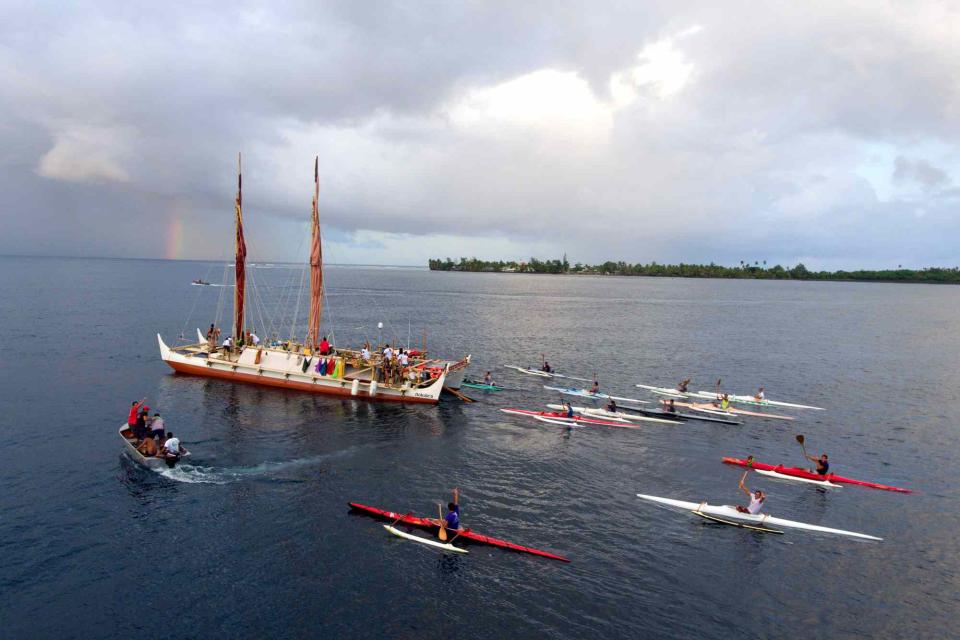
© 2017 POLYNESIAN VOXAGIN SOCIETY/NAVALERYANTHONY/GIMI TV
On an overcast day in April 2022, as misty clouds shrouded the mountain towering behind Tahiti's Papeete Harbor, hundreds gathered along the palm-fringed beach in Paofai Park. With their eyes fixated on an approaching double-hulled canoe with scarlet sails, the spectators cheered as the vessel gracefully glided toward the shore.
This was Hōkūle'a, the legendary replica of a traditional Polynesian canoe completing the "Kealaikahiki," or the voyage from Hawaii to Tahiti. One thing made this journey unlike any other in its almost 50-year history, though: it was captained by a woman. Lehua Kamalu would go down in history as the first woman to have navigated and led Hōkūle'a in its 2,400-mile journey, completed in just 17 days.
Kamalu is part of a growing number of women taking part in the ancient Polynesian tradition of navigating the ocean using nature as a guide — a sacred practice that was only available to men for thousands of years. Now, a new generation of female voyagers is connecting with their past and honoring their ancestors, and in the process, claiming their place on voyaging canoes.
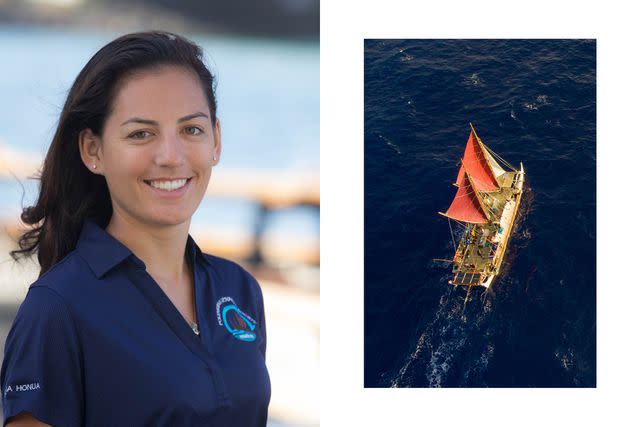
Courtesy of Lehua Kamalu; © 2017 POLYNESIAN VOXAGIN SOCIETY/NAVALERYANTHONY/GIMI TV
Raised in Hawaii, Kamalu was well-versed in the culture and history of her ancestors, including their voyaging legends. She was fascinated with Hōkūle'a, as its first voyage from Hawaii to Tahiti in 1976 brought wayfinding back from the brink of extinction. Last year, the vessel completed its eighth journey.
"I think we always were enthralled by voyaging. I did not think it was something that was remotely attainable to the average human. We really just thought of navigators as almost supernatural heroes," Kamalu told Travel + Leisure.
So, 14 years ago, as a mechanical engineering student at the University of Hawaii Manoa, she volunteered with the Polynesian Voyaging Society, an Oahu-based non-governmental organization tasked with preserving the tradition of Polynesian voyaging. Her first job in this world, sanding the canoe, led her to become an apprentice navigator and, eventually, a captain.
Kamalu explained that the voyaging community in Hawaii is a welcoming place and that, as long as you have a passion for navigating and the stamina to do it, gender doesn't matter. However, she recounted that early on in her career, she emulated the type of leadership she saw in her teachers, who were men. As she felt more confident in her skills and knowledge as a captain and navigator, she started carving out space for herself by tapping into her own leadership style.
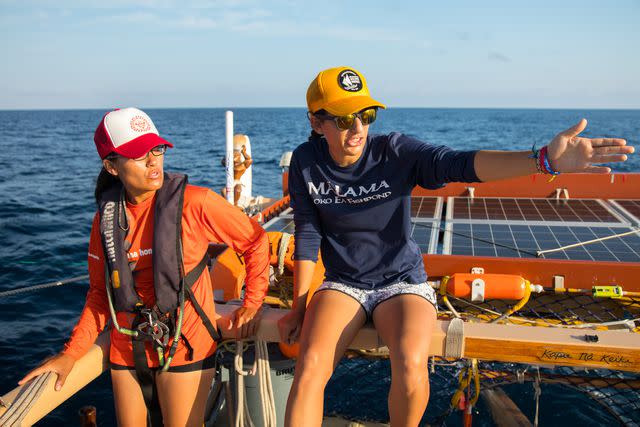
Courtesy of Lehua Kamalu
"We are our own worst critics," Kamalu said. "There's a very high standard placed on the work we do. There's no room for error or failure. When you're on the brink of losing something like navigation, there's not a lot of room to mess up."
Polynesians are part of the Austronesian peoples, who originated from the islands that are now the Philippines, Indonesia, the Salomon Islands, and the region north of Papua New Guinea. After developing elaborate techniques for building two-hulled canoes that could withstand long journeys in the open ocean — as well as new ways to store the fresh water, food, and plants needed to survive those voyages — they ventured out into the Pacific, colonizing Fiji, Samoa, and Tonga around 500 B.C.E. After approximately 1,000 to 1,500 years, they continued on toward Tahiti and Hawaii, navigating thousands of nautical miles using their knowledge of the stars, the sun, and ocean swells to guide them.
"The history of these people is the history of their migration out of the Western Pacific," Christina Thompson, the author of "Sea People: The Puzzle of Polynesia," told T+L. "It is the core, the root of the Polynesian diaspora."
Then, the knowledge and practice of Polynesian wayfinding, nearly disappeared. In the 17th and 18th centuries, when the Europeans reached the Polynesian Triangle — Hawaii to the north, Easter Island to the east, New Zealand to the south, and Tahiti in the center — there were few expeditions to be found. History remains silent about what caused ancient Polynesians to stop long-distance voyaging.
In the 1950s, Andrew Sharp, a New Zealand historian, suggested Polynesians had stumbled on the Pacific islands by chance. Some 20 years later, in an attempt to prove Sharp's theory wrong, anthropologist Ben Finney built a 61-foot replica of a traditional Polynesian canoe with help from a local surfer and an artist in Honolulu. The vessel — named Hōkūle'a after Arcturus, the zenith star of the Hawaiian Islands — was to sail to Tahiti and back, using traditional navigation techniques, to prove that ancient navigation was calculated, rather than a game of chance.
With the knowledge of wayfinding lost in Hawaii and much of Polynesia, finding someone who could navigate Hōkūle'a proved challenging. It fell to Pius "Mau" Piailug, who lived on Satawal in the remote Caroline Islands of Micronesia.
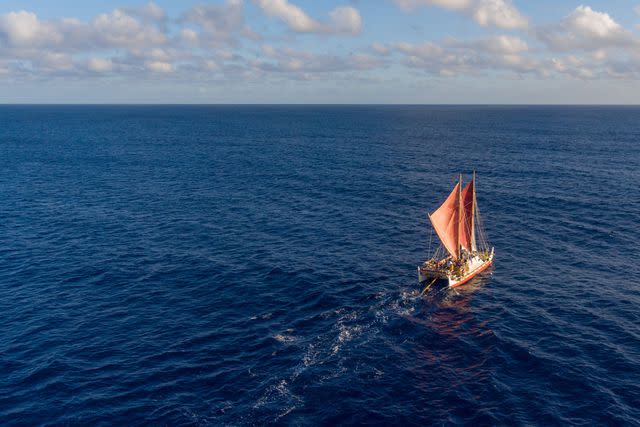
© 2017 POLYNESIAN VOXAGIN SOCIETY/NAVALERYANTHONY/GIMI TV
On May 1, 1976, Hōkūle'a left Maui with an all-male crew, including Piailug, for the 2,400-mile journey from Hawaii to Tahiti. In 34 days, the double-hulled canoe arrived in Papeete Harbor, where some 17,000 people had lined up along the shoreline to celebrate the revival of this ancient tradition. On its way back, a different crew of 11 men and two women — Keani Reiner and Penny Martin — guided Hōkūle'a back to Hawaii. Reiner and Martin became the first two women to be part of a crew on a Polynesian voyaging canoe in more than two centuries, paving the way for others.
"The reinvention and rediscovery of voyaging in the modern era are interesting," Christina Thompson said. "On the one hand, it's going back to something old, but in many ways, it's actually been going forward to something new. It's syncretic."
One of Hōkūle'a's original crew members was Nainoa Thompson. As the president of the Polynesian Voyaging Society and a master navigator initiated in the sacred pwo ceremony, he continues to be instrumental in steering celestial navigation in a more inclusive direction. After the success of Hōkūle'a's maiden voyage and under his guidance, more women have become involved with navigating and taken on leadership roles in the field. He got permission from his teacher and mentor, Piailug, to initiate women as master navigators via the pwo ceremony, once only celebrated for men.
"Women learn better than men. They are more disciplined. They are more focused. They are more committed long-term. They don't let stuff get in the way of their learning," Nainoa Thompson told T+L.
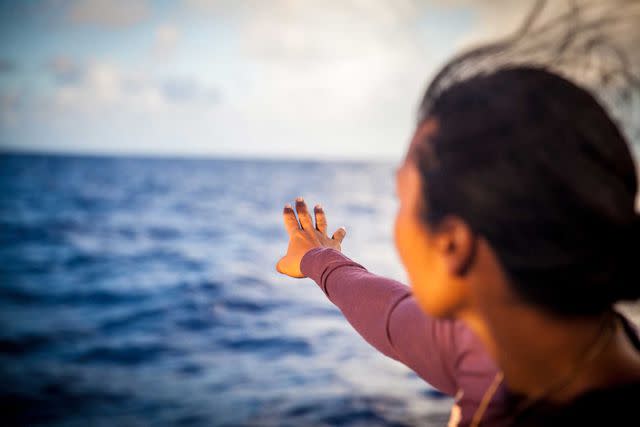
Courtesy of Four Seasons Resort Maui
One of the women who has since become an essential member of the Hawaiian voyaging community is Kala Baybayan Tanaka. For her, voyaging is a true family affair. She remembers seeing off her late father, Chad Kālepa Baybayan, a pwo navigator and a captain, on many of his voyages. However, she didn't sail with him until her college years.
One day, she joined her father and crew on a sail from Oahu to Maui, and she remembered being struck that the entire crew was male. "I was the only female. And I asked my dad, 'Do women belong in a canoe?' And he was really firm and said, 'It doesn't matter your gender. What matters is that you want to be here, your desire to learn,'" she told T+L.
She would go on to sail several legs on Hōkūle'a. Tanaka loves long-distance voyages as they bring her closer to her ancestors. "The ocean was their road. They were all over the place," she said.
And while she still sails, she has focused her efforts on educating the next generation of voyagers. She is involved with the Hui o Wa'a Kaulua, Maui's Voyaging Society, teaching children and visitors the history and techniques of voyaging. "If I can help get others on a canoe, then that means the tradition of voyaging will continue on," she added.
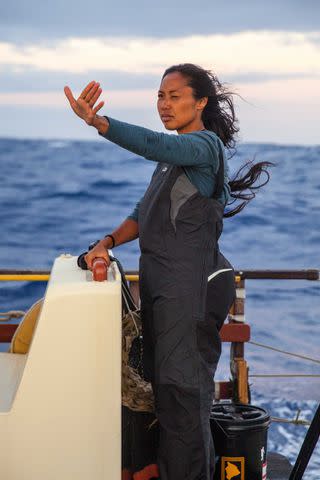
Courtesy of Four Seasons Resort Maui
Tanaka and Kamalu now have important roles, not just on the canoes but also as leaders and role models for younger women picking up their ancestors' wayfinding traditions.
For Kai Hoshijo, watching the likes of Tanaka and Kamalu made her want to pursue navigating three years ago. "It's very, very important to have female role models," Hoshijo told T+L, adding that seeing female navigators and captains was "something my mom and my grandmother weren't able to access, so it's pretty inspiring."
The 25-year-old also admitted that being a woman on the canoe, especially in a leadership role, is difficult. "I do think that women, and especially in maritime roles, have to be not just good, but excellent," she said. "It's difficult to get to those places and maintain that space, for not only yourself but for others."
Hoshijo said a huge part of long-distance voyaging is establishing relationships and partnerships across the Pacific and the world, as it strengthens the tradition of voyaging. And she is preparing to do exactly that as part of Hōkūle'a 15th major voyage.
On June 15, the legendary canoe began an epic 47,000-mile journey, Moananuiākea, circumnavigating the Pacific. It will take four years to complete, reaching nearly 100 Indigenous territories in 36 countries, it's the longest voyage to date. The goal is to encourage young leaders and educate and engage a new generation of voyagers "while amplifying the vital importance of our oceans, nature, science, and Indigenous wisdom."
This time, unlike its first voyage almost 50 years ago, a rotating crew of 400 members, men and women, from around the globe will work together to ensure the practice of wayfinding endures.
"Tradition is just a history of change. Culture evolves, culture shifts," Nainoa Thompson said. "That's how we survive."
For more Travel & Leisure news, make sure to sign up for our newsletter!
Read the original article on Travel & Leisure.

